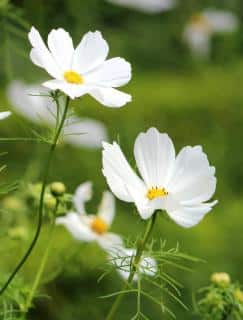

Cosmos is a very cute little annual plant, very trendy nowadays.
Key Cosmos facts:
Name – Cosmos
Family – Asteraceae
Type – annual
Height – 8 inches (20 cm) to 5 feet (1.5 meters) depending on the variety
Exposure – full sun
Soil: ordinary, rather light and well drained – Flowering: end of spring → mid-fall
A very easy plant to succeed in growing, the blooming is abundant and its decorative effect is guaranteed.
In spring, right from the middle of the month of April, choose a full sun location to sow your cosmos.
If you live in areas that are farther up North, best sow starting from the month of May.
 In summer, it is always possible to plant your cosmos plants purchased in a nursery pot, but the most common technique is to sow them directly from seed.
In summer, it is always possible to plant your cosmos plants purchased in a nursery pot, but the most common technique is to sow them directly from seed.
Just like the aster, ordinary soil mixed with a bit of soil mix is perfect.
 Easy to grow, cosmos only asks for very little care.
Easy to grow, cosmos only asks for very little care.
For long stemmed varieties, feel free to stake them to avoid having them double over in case of wind.
Deadheading will help renew blooms. It also makes the flowers seem perpetually fresh!
A plant for flower beds, edges or rocky land, cosmos is spectacular from spring to fall thanks to its generous blooming which constantly renews itself.
An easy annual, there are many different varieties and species which makes for just as many shapes and colors.
As for pests and diseases, Cosmos is rather something of a paradox:
 These can be divided into three large groups, for the most common flowers
These can be divided into three large groups, for the most common flowers
Not a very hardy plant, cosmos cannot withstand temperatures below freezing. This goes for all varieties. It explains why it must be grown as an annual in cold climates.
From the three groups mentioned above, only two are traditionally regarded as edible: Cosmos sulphureus and Cosmos caudatus.
The most common Cosmos family, Cosmos bipinnatus, is not considered edible. Since it isn’t toxic in any manner though, it’s still very safe to grow around children and pets.
Cosmos is one of the favorite flowers of bees and other beneficial insects.
Leave some of the flowers that have gone to seed on the plant to attract birds who land on the plant and eat the seeds directly from the withering flowers! Don’t deadhead all the flowers.
I just love Cosmos! They grew so well in California… just add water. I figured Houston, TX, with it’s tropical climate might not work. But I’m gonna give them a try.
And edible? After all these years loving this flower, I didn’t know it was edible either. Definitely gonna get some going in the Spring, here… Around the middle of January… LOL.
It’s true that Cosmos is edible! Petals are best. Not really tasty but beautiful to top a fresh salad mix! A word of caution, however: the most common type of cosmos isn’t really edible. It’s the other two, Cosmos sulphureus and Cosmos caudatus that can be eaten when young.